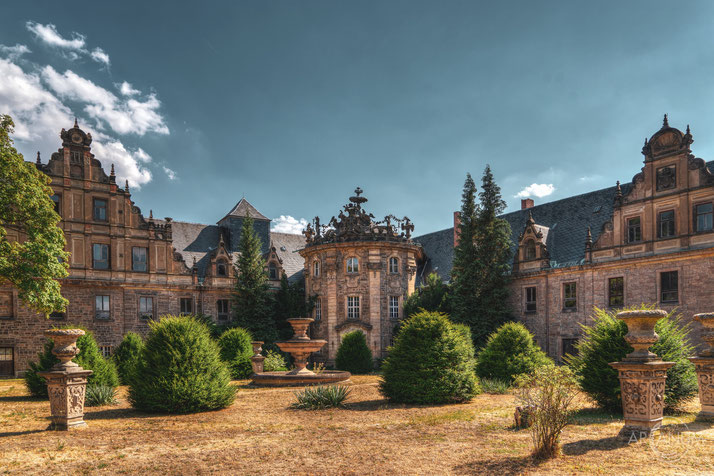The Movie Castle
Vitzenburg Castle is a Renaissance and Neo-Renaissance castle on the Unstrut that dates back to a castle that was probably founded in the 9th century.
In the register of the Hersfeld monastery, which was written down between 881 and 899, both the place and the castle Vitzenburg itself are mentioned for the first time. However, nothing is known about the size and shape of this early castle.
Before 991 the noble Brun and his wife Adilint founded a convent. The nunnery lay within the castle, which continued to exist.
According to the chronicles, the distinguished and wealthy Vizo de Vizemburch had transferred his goods, including the castle and monastery, shortly before his death to his relatives Wiprecht von Groitzsch. According to the chronicle, Wiprecht had to intervene against the increasing moral decline of the monastery inmates. He is said to have then expelled the nuns from the monastery and founded a new monastery near the river Unstrut, occupied it with monks and transferred the goods from the nunnery to it. After Wiprecht's death, the castle came into the possession of the Wettins. From the 1160s, a number of nobles and ministerials appeared, which named themselves after the castle.
The Weißenfels Treaty of 1249 stipulated that all castles located in the county and newly listed should be destroyed. The Vitzenburg is also named among these. The extent of this destruction and the shape of the castle at the end of the High Middle Ages are not known.
According to a document from April 1302, the Vitzenburg was owned by Heinrich Schenk von Vitzenburg.
Gerhard, noble gentleman of Querfurt, acquired the castle for his son Bruno III. by the heavily indebted Rudolf Schenk von Vitzenburg. Several nobles lived in the castle, until it was sold to Hans von Selmenitz on May 15, 1464.
Due to the economic grievances and the high debt, the von Semnitz brothers had to sell the Vitzenburg to Joachim von Lichtenhayn in 1521. In the course of the Reformation in 1540, the Vitzenburg Monastery, which was badly devastated in the Peasants' War in 1524–1526, was finally abolished. Nickel and Valten von Lichtenhayn had the partly burned out bailey rebuilt and rebuilt from 1574 to 1587. Under Valten von Lichtenhayn in 1586/87 the Vitzenburg Castle was converted into a two-wing Renaissance castle with a stair tower
Due to the effects of the Thirty Years' War and the resulting debt burden, the sons of Nickel von Lichtenhayn were forced to cede Vitzenburg Castle to Colonel-Lieutenant Hans Heinrich II von Heßler, Lord of Burgheßler and Balgstedt.
In 1695, war commissioner Georg Friedrich von Hessler had the north wing of the palace expanded in baroque forms. From 1764 to 1767 the entire palace and the former monastery were renovated in the Baroque style under the direction of the district councilor Friedrich Moritz von Hessler.
After the death of the district councilor Friedrich Moritz von Hessler on Vitzenburg, Count Heinrich Moritz I of the Schulenburg inherited the castle. After 1843, Count Heinrich Moritz II had the castle rebuilt in the neo-renaissance and neo-baroque style while maintaining its basic shape. The architect Max Wallenstein carried out further reworking of the castle from 1880 to 1884.
With the death of Werner Christoph Daniel Graf von der Schulenburg-Heßler on June 17, 1930 the house of the Schulenburg on Vitzenburg died out in male lines. In his will of 1925, he had his daughter Auguste Marie Anna Freifrau von Münchhausen as sole heir.
After the end of the Second World War, Auguste's husband Rembert Freiherr von Münchhausen, lord of Vitzenburg, remained at his castle even after the American occupation forces left. He was arrested by the Soviet occupation forces and taken to Special Camp No. 2 in Buchenwald, where he died on July 14, 1947.
The property belonging to the von Münchhausen family on Vitzenburg, Steinburg and Herrengosserstedt was expropriated and distributed to new farmers and agricultural workers. The estates were managed by a trustee.
The castle was converted into a school estate, and a youth home was set up here. For a time it served as a training center for teachers who would later teach apprentices in agriculture.
In 1948 the "Vitzenburg Agricultural School with attached Provincial School Estate" was founded. When the school moved out, the castle was officially handed over to the specialist hospital for child and adolescent psychiatry and on December 11, 1969.
The psychiatric hospital was closed in 1996 and became abandoned. The same year, an architect bought Vitzenburg Castle from the "Treuhandanstalt" for one German Mark.
The park, the grounds and the vineyards have been restored and made accessible through job creation measures.
Due to bankruptcy, the castle was foreclosed at the end of June 2004 for 395,000 euros.
In 2013 the castle was the location for the film Bibi & Tina. Director Detlev Buck chose it as the backdrop for the fictional Falkenstein Castle. Also in the sequels Bibi & Tina: fully bewitched! (2014), Bibi & Tina: Mädchen gegen Jungs (2016) and Bibi & Tina: Tohuwabohu Total (2017) were shot at Vitzenburg Castle.
Source: Wikipedia







































































